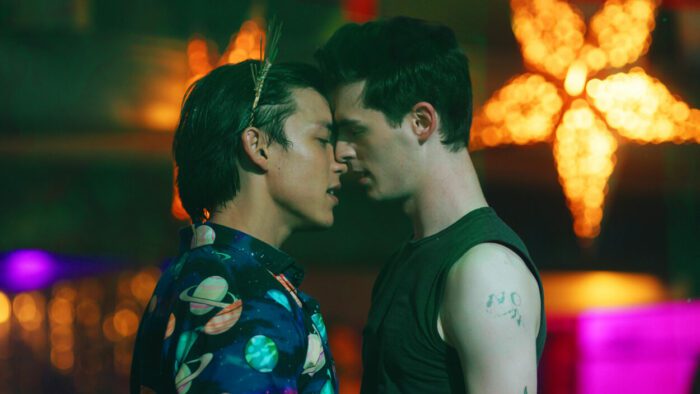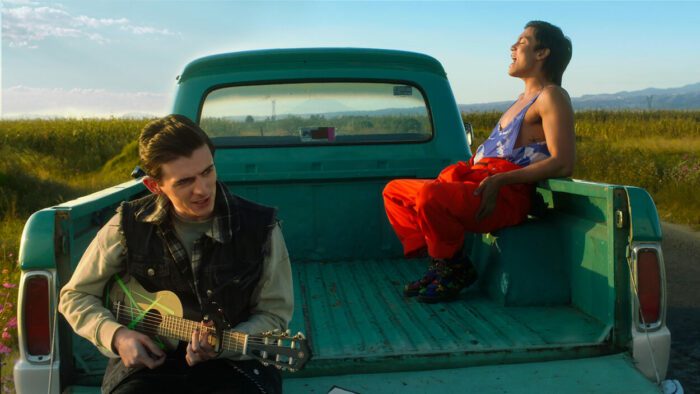Glitter & Doom feels like karaoke night at a friend’s house. The only problem is that no one really remembers the songs, and few seem to know why they’re there. Yet, nobody appears to be having a bad time, so complaints feel cynical. At the end of the evening, it’s a good time that’s ultimately forgettable.
The movie follows the whirlwind romance of the titular characters. Glitter is an aspiring clown, while Doom has designs on being a musician. Chance encounters lead them to falling head over heels in love. However, the strains of their personal problems threaten to pry them apart. It’s only when love gives them the strength to push through their difficulties that everything starts coming together.

Glitter & Doom borders on being a cookie cutter motion picture. What’s meant to set this rendition of manic-pixie-completes-the-brooding-artist apart is by being a jukebox musical. To that end, every song is borrowed from the Indigo Girls.
The folk rock duo Emily Saliers and Amy Ray have been around since 1987. Although they never achieved superstar status, they’ve always possessed a passionate fandom. And now, their prolific career is on a fresh rising wave. Last year’s Barbie repeatedly featured their song “Closer to Fine” and a documentary about the band entitled Indigo Girls: It’s Only Life After All is hitting select theaters this April. Add Glitter & Doom to the mix, Spotify playlists are sure to include plenty of Indigo Girls this year.
Alan Cammish and Alex Diaz who play Doom and Glitter do most of the singing. This features renditions of “Bitterroot”, “World Falls”, “Keeper of My Heart”, and “Power of Two”; songs spanning the Indigo Girl’s long career. There’s even a version of “Match” off Emily Saliers’ solo debut Murmuration Nation. While they sound okay, the borrowed songs have mostly been arranged in ways which make them indistinguishable from a generic musical. Worse, few of them stand out sonically which keeps them from feeling distinct. Too many songs in Glitter & Doom sound the same making the emotions in some scenes hard to pin down aurally, not to mention making things a tad monotonous.

Still, the movie does include worthwhile themes. There’s nothing wrong with a little saccharine optimism now and again, embracing a love conquers all mentality. That’s especially refreshing given how LGBTQ+ positive Glitter & Doom is. The problem is that the movie is very superficial when it comes to these themes. Although certain deeper elements are glimpsed throughout the movie, they’re poorly explored. What could have been fodder for quality melodrama is ignored hurrying to the next musical number.
For instance, their romance and personalities are so formulaic Glitter & Doom sometimes forgets to elaborate on either. Bullet point exposition relates character aspects more than any interaction. The story then jumps along expected outcomes instead of paving a path to them.
Consequently, the main characters become generic. It also makes their relationships with others hollow. Except for Glitter and Doom’s mothers, played by Ming-Na Wen and Missi Pyle respectively, there’s no real sense of why various people are here. Although it’s easy to discern this or that individual is a friend, or another is a parent, what isn’t apparent is why they have a connection. Friends only seem to appear in the film to compel the main characters towards a different plot point.
A lot of Glitter & Doom is simply interactions between the titular characters. Alan Cammish does a marvelous job of being an angsty musician striving to find a way to share his outlook musically. Alex Diaz is often a theater kid cliché almost overacting on occasion, but when it comes to quieter intimate moments, genuine feelings come across. However, there isn’t enough to these characters to make them captivating for almost two hours. Other parts filled out by the likes of Lea DeLaria, Ali Salguero, and Viry Dimayuga do well with their roles, but again, there isn’t much depth to their parts.

Cory Krueckeberg apparently wrote Glitter & Doom for director Tom Gustafson as a gift to commemorate their 20th anniversary. Perhaps the love behind that inspired the vibrance of the film’s appearance. It is a bright feature full of color. At times, the screen glows with kaleidoscopic rainbow brilliance. However, the movie can also be a bit too literal such as when characters set off fireworks while spouting the lyrics, “Light up the sky like the fourth of July.” Moments when the visuals are compelling, such as Doom walking a graffiti lined alley that mirrors moments in his life, remind of the prosaic nature of too many other scenes.
Glitter & Doom is a sweet movie with a wonderful message about love making people stronger. It’s yin and yang romance may not be terribly original, but that would be more forgivable if the story offered more interesting character exploration or cinematic visuals. The jukebox musical angle utilizes a wonderful source, though most renditions are pale imitations of better versions. Glitter & Doom isn’t a bad time, but there aren’t many praises to sing.
Furthermore, one recommendation I would make is that anyone hearing impaired ensure they watch this through a source with the best possible closed captions. Personal experience has shown several services are imperfect to put it mildly, and language is important, especially while watching a musical — what’s sung is setting the scene. Regrettably, I don’t know where to advise viewers to seek the best possible option. However, it is worth keeping in mind since parts of Glitter & Doom, not simply the music, will seem to stumble when the captions don’t make sense. Sometimes, they may not even show the words characters deliver. Again, this is a recurring problem for a lot of films but may make a musical a particularly galling experience for the hearing impaired. And anyone wondering why someone with hearing difficulties might even consider watching a musical, the poetry of quality lyrics alongside the visual vibrance of such films is all you need to know.


